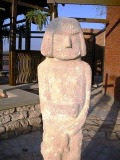This story was given to us by Erika Espin Reyes and you can read it along with others on her personal blog http://www.byceversa.blogspot.com/ The decision to keep it the same as the original is to not lose the essence of the message that our blog follower wants to convey.
Among the various icons of worship of our Manteña confederation - that which is today a large part of the province of Santa Elena and Manabí, which by seeing them we could know what all Ecuadorians would have been like if the Spanish ruins, the inhabitants of Ecuador at the time of the pear, had not arrived here in their thirst for adventure and greed - there is one that still survives and they call it the Lord of Waters and Fertility, the Lord of Zacachúm, "San Biritute".
Handcrafted from marine conglomerate stone (conchilla), 2.35 meters high, it stands out for its interesting carving and its protruding virile member. He is found seated, touching his member with one hand, with a hat as a helmet and a straight nose on his face; he was in the ceremonial and worship center of Las Negras hill next to “Las Tetonas”, which is now in the Las Juntas commune and the “Guasango Totem”, which adorns the entrance of the Municipal Museum of the city of Guayaquil, in the times of the so-called Guangala culture, I believe.
My undergraduate thesis was about San Biritute and the Sacachún commune back in 2004. The acceptance to develop this bizarre topic came about because I knew the sad journey and suffering of the god from Manteño since the 1950s: they told me the story and I couldn't help but fall before the fantastic mirage that it was to work on that for a little over a year and even until now.
“His name was, we were told, “Saint Biritute” and he had the gift of “making it rain”, among many others, when he was asked for it with true devotion, and if despite their pleas he remained impassive, “he would turn a deaf ear”, his devotees would resort to measures of unsuspected force. A kind of executioner-priest was appointed, and this one, armed with a tremendous leather whip, would beat the God with such violence that sparks would burst from his chalky body, while the women, contemplating the scene, shouted in chorus: - Do not hit Saint Biritute! Do not hit him”, like a group of mourners escaping from a Roman frieze. The last executioner was Eugurio Tomalá, who, by giving the sculpture its final lashing, provoked torrential rains and the wrath of the god, since malignant fevers killed the unfortunate cholo in a few weeks.” Francisco Huerta Rendón, 1955.
During those years, amidst euphoria and thanks to curuchupas and the snitch, they say, armed municipal guards arrived in Sacachún and took San Biritute away in the name of religion and against paganism. Since then, hardship has come. For more than 44 years it has been located on Av. 10 de Agosto in Guayaquil, it was painted white to match the edges of the flowerbeds, from there it was put in a warehouse, and finally it became an object of exhibition in the Municipal Museum, until now. Needless to say, the commune has asked for its return but has not received a response.
Currently, in the commune of Sacachún, a museum-like roundabout has just been inaugurated in homage to the lord of the waters and a replica of the monolith is also planned, which has been placed in the same place where it was found more than 50 years ago: next to the wooden cross that the Franciscans placed there so that people would worship their cross and not the saint.
Should San Biritute return to Sacachún? Popular imagination and its ineloquent beliefs believe and hope so. The commune is preparing to turn this belief into a secondary form of economic income, a strange idea they call tourism. We will have to see what comes of that.
Until then I will light my candle to the saint so that when the mess starts the Lord of the Mustaches does not get upset.
![]()

